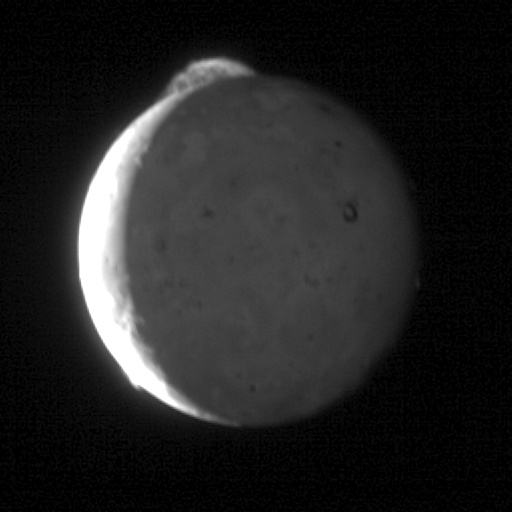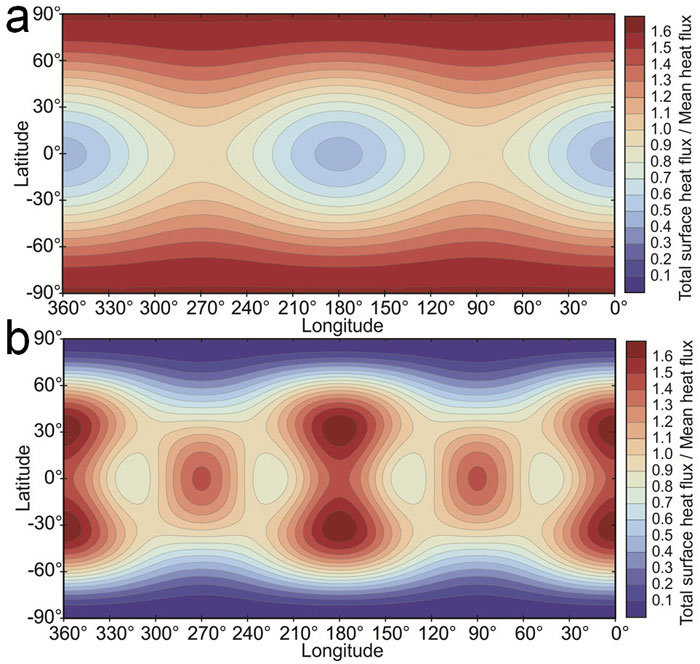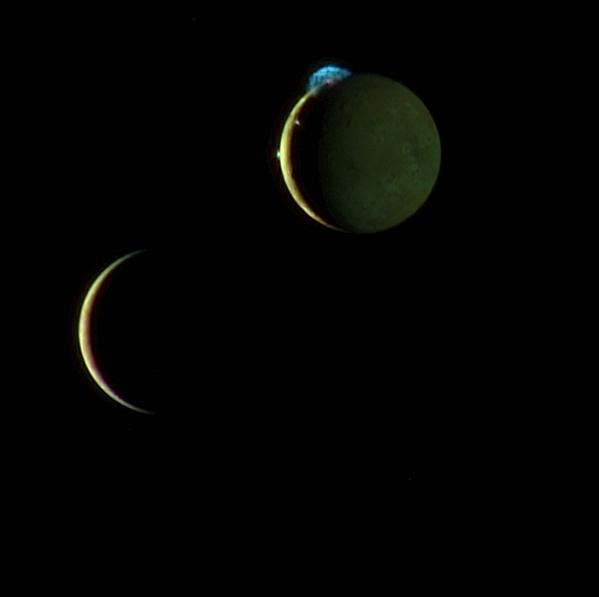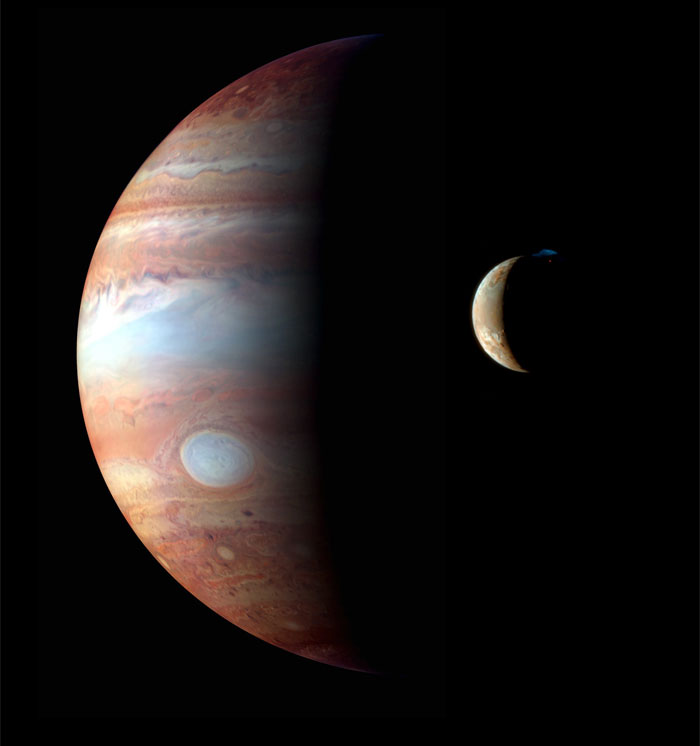.
Jupiter's moon Io is the most volcanically active world in the Solar System, with hundreds of volcanoes, some erupting lava fountains up to 250 miles high. However, concentrations of volcanic activity are significantly displaced from where they are expected to be based on models that predict how the moon's interior is heated, according to NASA and European Space Agency researchers.
.

This five-frame sequence of images from NASA's New Horizons mission captures the giant plume from Io's Tvashtar volcano. Snapped by the probe's Long Range Reconnaissance Imager (LORRI) as the spacecraft flew past Jupiter in 2007, this first-ever movie of an Io plume clearly shows motion in the cloud of volcanic debris, which extends 330 km (205 miles) above the moon's surface. Only the upper part of the plume is visible from this vantage point. The plume's source is 130 km (80 miles) below the edge of Io's disk, on the far side of the moon. Io's hyperactive nature is emphasized by the fact that two other volcanic plumes are also visible off the edge of Io's disk: Masubi at the 7 o'clock position, and a very faint plume, possibly from the volcano Zal, at the 10 o'clock position. Jupiter illuminates the night side of Io, and the most prominent feature visible on the disk is the dark horseshoe shape of the volcano Loki, likely an enormous lava lake. Boosaule Mons, which at 18 km (11 miles) is the highest mountain on Io and one of the highest mountains in the solar system, pokes above the edge of the disk on the right side. The five images were obtained over an 8-minute span, with two minutes between frames, from 23:50 to 23:58 Universal Time on 1 March 2007. Io was 3.8 million km (2.4 million miles) from New Horizons.
Credit: NASA/Johns Hopkins University Applied Physics Laboratory/Southwest Research Institute
.
Io is caught in a tug-of-war between Jupiter's massive gravity and the smaller but precisely timed pulls from two neighboring moons that orbit further from Jupiter – Europa and Ganymede. Io orbits faster than these other moons, completing two orbits every time Europa finishes one, and four orbits for each one Ganymede makes. This regular timing means that Io feels the strongest gravitational pull from its neighboring moons in the same orbital location, which distorts Io's orbit into an oval shape. This in turn causes Io to flex as it moves around Jupiter.
For example, as Io gets closer to Jupiter, the giant planet's powerful gravity deforms the moon toward it and then, as Io moves farther away, the gravitational pull decreases and the moon relaxes. The flexing from gravity causes tidal heating -- in the same way that you can heat up a spot on a wire coat hanger by repeatedly bending it, the flexing creates friction in Io's interior, which generates the tremendous heat that powers the moon's extreme volcanism.
The question remains regarding exactly how this tidal heating affects the moon's interior. Some propose it heats up the deep interior, but the prevailing view is that most of the heating occurs within a relatively shallow layer under the crust, called the asthenosphere. The asthenosphere is where rock behaves like putty, slowly deforming under heat and pressure.
"Our analysis supports the prevailing view that most of the heat is generated in the asthenosphere, but we found that volcanic activity is located 30 to 60 degrees East from where we expect it to be," said Christopher Hamilton of the University of Maryland, College Park. Hamilton, who is stationed at NASA's Goddard Space Flight Center in Greenbelt, Md., is lead author of a paper about this research published January 1 in Earth and Planetary Science Letters.
Hamilton and his team performed the spatial analysis using the a new, global geologic map of Io, produced by David Williams of Arizona State University, Tempe, Ariz., and his colleagues using data from NASA spacecraft. The map provides the most comprehensive inventory of Io's volcanoes to date, thereby enabling patterns of volcanism to be explored in unprecedented detail. Assuming that the volcanoes are located above where the most internal heating occurs, the team tested a range of interior models by comparing observed locations of volcanic activity to predicted tidal heating patterns.
"We performed the first rigorous statistical analysis of the distribution of volcanoes in the new global geologic map of Io," says Hamilton. "We found a systematic eastward offset between observed and predicted volcano locations that can't be reconciled with any existing solid body tidal heating models."
Possibilities to explain the offset include a faster than expected rotation for Io, an interior structure that permits magma to travel significant distances from where the most heating occurs to the points where it is able erupt on the surface, or a missing component in existing tidal heating models, like fluid tides from an underground magma ocean, according to the team.
.

This is a map of the predicted heat flow at the surface of Io from different tidal heating models. Red areas are where more heat is expected at the surface while blue areas are where less heat is expected. Figure A shows the expected distribution of heat on Io's surface if tidal heating occurred primarily within the deep mantle, and figure B is the surface heat flow pattern expected if heating occurs primarily within the asthenosphere. In the deep mantle scenario, surface heat flow concentrates primarily at the poles, whereas in the asthenospheric heating scenario, surface heat flow concentrates near the equator. Credit: NASA/Christopher Hamilton
.

This is a composite image of Io and Europa taken March 2, 2007 with the New Horizons spacecraft. Here Io (top) steals the show with its beautiful display of volcanic activity. Three volcanic plumes are visible. Most conspicuous is the enormous 300-kilometer (190-mile) high plume from the Tvashtar volcano at the 11 o'clock position on Io's disk. Two much smaller plumes are also visible: that from the volcano Prometheus, at the 9 o'clock position on the edge of Io's disk, and from the volcano Amirani, seen between Prometheus and Tvashtar along Io's terminator (the line dividing day and night). The Tvashtar plume appears blue because of the scattering of light by tiny dust particles ejected by the volcanoes, similar to the blue appearance of smoke. In addition, the contrasting red glow of hot lava can be seen at the source of the Tvashtar plume. This image was taken from a range of 4.6 million kilometers (2.8 million miles) from Io and 3.8 million kilometers (2.4 million miles) from Europa. Although the moons appear close together in this view, a gulf of 790,000 kilometers (490,000 miles) separates them. Io's night side is lit up by light reflected from Jupiter, which is off the frame to the right. Europa's night side is dark, in contrast to Io, because this side of Europa faces away from Jupiter.
Credit: NASA/Johns Hopkins University Applied Physics Laboratory/Southwest Research Institute
.
The magnetometer instrument on NASA's Galileo mission detected a magnetic field around Io, suggesting the presence of a global subsurface magma ocean. As Io orbits Jupiter, it moves inside the planet's vast magnetic field. Researchers think this could induce a magnetic field in Io if it had a global ocean of electrically conducting magma.
"Our analysis supports a global subsurface magma ocean scenario as one possible explanation for the offset between predicted and observed volcano locations on Io," says Hamilton. "However, Io's magma ocean would not be like the oceans on Earth. Instead of being a completely fluid layer, Io's magma ocean would probably be more like a sponge with at least 20 percent silicate melt within a matrix of slowly deformable rock."
Tidal heating is also thought to be responsible for oceans of liquid water likely to exist beneath the icy crusts of Europa and Saturn's moon Enceladus. Since liquid water is a necessary ingredient for life, some researchers propose that life might exist in these subsurface seas if a useable energy source and a supply of raw materials are present as well. These worlds are far too cold to support liquid water on their surfaces, so a better understanding of how tidal heating works may reveal how it could sustain life in otherwise inhospitable places throughout the Universe.
"The unexpected eastward offset of the volcano locations is a clue that something is missing in our understanding of Io," says Hamilton. "In a way, that's our most important result. Our understanding of tidal heat production and its relationship to surface volcanism is incomplete. The interpretation for why we have the offset and other statistical patterns we observed is open, but I think we've enabled a lot of new questions, which is good."
Io's volcanism is so extensive that it gets completely resurfaced about once every million years or so, actually quite fast compared to the 4.5-billion-year age of the solar system. So in order to know more about Io's past, we have to understand its interior structure better, because its surface is too young to record its full history, according to Hamilton.
The research was funded by NASA, the NASA Postdoctoral Program, administered by Oak Ridge Associated Universities, and the European Space Agency.
.

This is a montage of New Horizons images of Jupiter and its volcanic moon Io, taken during the spacecraft's Jupiter flyby in early 2007. The image shows a major eruption in progress on Io's night side, at the northern volcano Tvashtar. Incandescent lava glows red beneath a 330-kilometer (205-mile-high) volcanic plume, whose uppermost portions are illuminated by sunlight. The plume appears blue due to scattering of light by small particles in the plume. Credit: NASA/Johns Hopkins University Applied Physics Laboratory/Southwest Research Institute/Goddard Space Flight Center
.
Quelle: NASA
5750 Views
